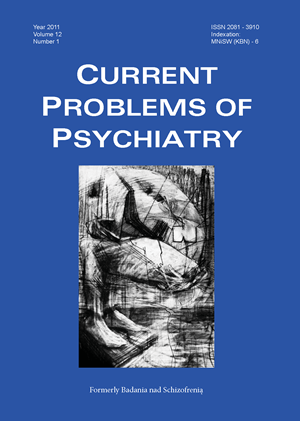Immunohistochemical assesment of etanol induced dangerof hepatocytes’ damage
Keywords:
etanol, HSP70, liverAbstract
Biodegradation of ethanol takes place mainly in the liver and liver is the most exposed to alcohol and its metabolite acetaldehyde. Free radicals and oxygen stress are responsible for alcohol induced destructions of the liver. Free radicals induce peroxidation of membranous lipids and increase membranes’ permeability.In present study we evaluated in immunohistochemical way expression of HSP 70 protein – biomarker of early ethanol induced danger in the cells. We examined an influence of time and dose of alcohol on HSP70 expression.
The study material consisted of white Wistar male rats divided into 5 equal groups – 8 individuals each Experimental groups: rats received per os single dose of 0,5 ml 40% ethanol and were decapitated after 1, 3, 8 and 12 hours. Control group: 8 rats decapitated after 1, 3, 8 and 12 hours of experiment – 8 individuals. Specimens of liver were examined using standard three-step immunohistochemical method to detect HSP70.
Single dose 0,5 ml of ethanol given to 300 g rats is similar to single dose 130ml of given to 80 kg men. One hour after such a dose the concentration in blood is 0,95‰, after 3 hours 0,6‰ and after 8 hours alcohol is eliminated from blood.
Results in present study show that HSP70 takes part in protection of hepatocytes’ proteins against ethanol induced toxicity. Expression of HSP70 increased in one hour after dose of ethanol and was on the same level after 3 and 8 hours. Its level decreased after 12 hours and was like in control group.
References
1. Chen T.H., Wang Y.H., Wu Y.H. Developmental exposures to ethanol or dimethylsulfoxide at low concentrations alter locomotor activity in larval zebrafish: Implications for behavioral toxicity bioassays. Aquat. Toxicol. 2011; 102: 162-166.
2. Jayaraman J., Namasivayam N. Naringenin modulates circulatory lipid peroxidation, anti-oxidant status and hepatic alcohol metabolizing enzymes in rats with ethanol induced liver injury. Fundam. Clin. Pharmacol., 2010, 24: 1472. [Epub ahead of print]
3. Orywal K., Jelski W., Szmitkowski M. The participation of ethanol in induction of carbohydrates metabolism disturbances. .Pol. Merk. Lek., 2009, 27: 157-168.
4. Bardina L.R., Pron'ko P.S., Satanovskaia V.I., Alieva E.V. Effects of catalase activators and inhibitors on ethanol pharmacokinetic characteristics and ethanol and aldehyde-metabolizing enzyme activities in the rat liver and brain. Biomed. Khim., 2010 ; 6: 499-505.
5. Werner J., Saghir M., Fernandez-del Castillo C. i wsp.: Linkage of oxidative and nonoxidative ethanol metabolism in the pancreas and toxicity of nonoxidative ethanol metabolites for pancreatic acinar cells. Surgery, 2001, 129, 736-744.
6. Kuch M. Komentarz redakcyjny. Białko szoku cieplnego – czy mamy już do czynienia z nowym markerem niedokrwienia? Kardiol. Pol., 2009; 67: 953-955.
7. Yoo J.L., Janz D.M. Tissue-specyfic HSP70 levels and reproductive physiological responses in fishes inhabiting a metal-contaminated creek. Arch. Environ. Contam. Toxicol., 2003; 45: 110-120.
8. Pedrycz A., Kosiecz D., Drelich G., Ossowska B.: Over-expression of biomarkers of environmental stress in renal epithelial cells resulting from proapoptotic activity of adriamycin: An immunohistochemical assessment. Curr. Probl. Psychiatry, 2010; 11(2): 161-165.
9. Wang S.Z., Wang L., Gao X.D., Cheng Z., Bi H.G., Wang D.Z. Influence of the expression of heat shock protein 70 in maxillofacial squamous cell carcinoma by thermochemotherapy. Hua Xi Kou Qiang Yi Xue Za Zhi, 2005; 23: 277-279.
10. Watson W.H., Song Z., Kirpich .IA., Deaciuc I.V., Chen T., McClain C.J. Ethanol exposure modulates hepatic S-adenosylmethionine and S-adenosylhomocysteine levels in the isolated perfused rat liver through changes in the redox state of the NADH/NAD(+) system. Biochim. Biophys. Acta, 2011; 2. [Epub ahead of print].
11. Cho S.Y., Yun J.W., Park P.J., Sohn J.H., Seo D.B., Lim K.M,. Kim W.G., Lee S.J. Effects of chitooligosaccharide lactate salt on activity of acetaldehyde dehydrogenase. J. Med. Food, 2010; 13:1061-1068.
12. Firdous A.P., Sindhu E.R., Kuttan R. Hepato-protective potential of carotenoid meso-zeaxanthin against paracetamol, CCl4 and ethanol induced toxicity. Indian J. Exp. Biol., 2011; 49: 44-49.
13. Schmitz I., Kirchhoff S., Krammer P.H.: Regulation of death receptor- mediated apoptosis pathways. Int. J. Biochem. Cell Biol., 2000; 32: 1123-1136.
Downloads
Published
Issue
Section
License
Copyright (c) 2011 Authors

This work is licensed under a Creative Commons Attribution-NonCommercial-NoDerivatives 3.0 Unported License.


